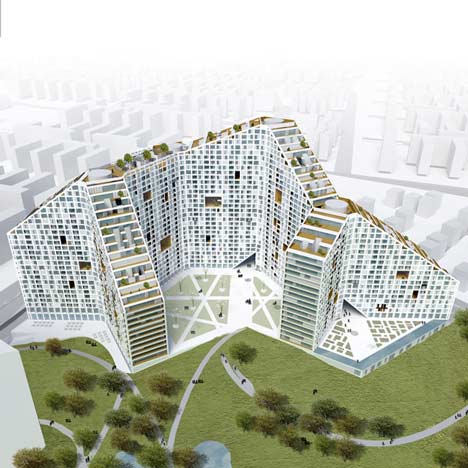
Future Towers India by MVRDV
Construction has begun on a large-scale housing development designed by Dutch firm MVRDV for Pune, India.
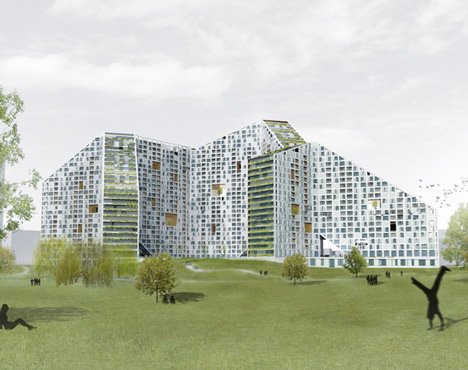
Called Future Towers India, the building will comprise 1,068 apartments plus a school, swimming pool, shops, bars, cafes and a cinema.
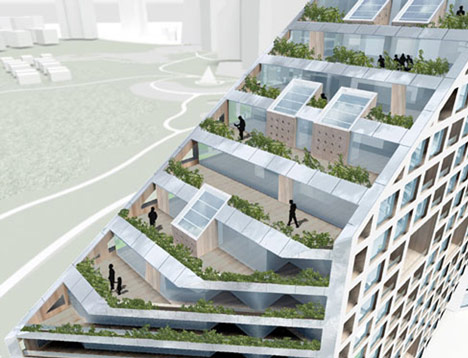
Nine wings will be arranged on a hexagonal grid around four cores, with raked roofs creating balconies and gardens.
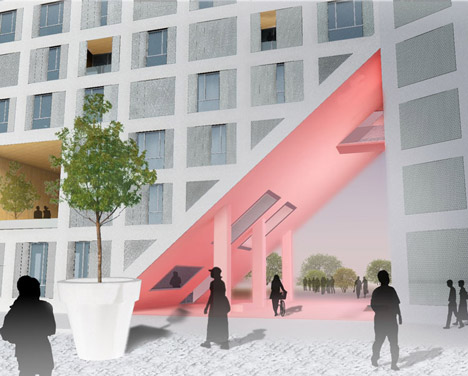
The facade will be concrete, with metal shutters, wooden balconies and stone-clad circulation spaces.
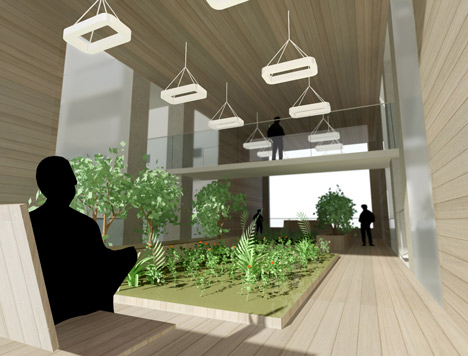
The project is due for completion in 2014 and will form part of a larger scheme to create 3,500 apartments in the area.
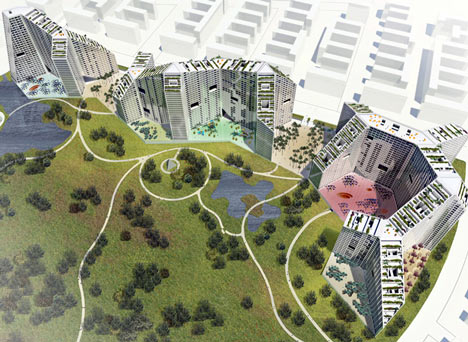

Click above for larger image
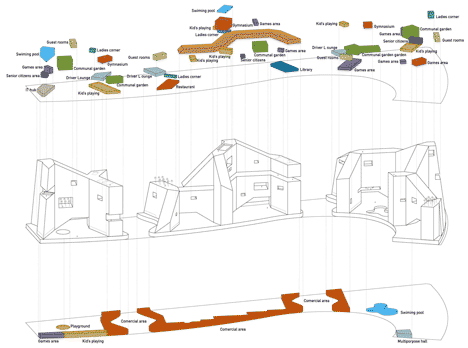
Click above for larger image
The information below is from the architects:
CONSTRUCTION START FOR VERTICAL CITY PROJECT: FUTURE TOWERS, 3500 APARTMENTS AND SERVICES IN PUNE, INDIA
City Corporation Ltd, a leading real estate development corporation in the Indian state of Maharashtra has started construction on the first phase of Amanora Apartment City - Future Towers, designed by MVRDV. The project is located in Pune, India and comprises 1,068 apartments & public amenities, as a part of a large scale housing development with a total of 400.000m2 comprising 3,500 apartments. Completion is expected by summer 2014. The apartments and facilities are interwoven and create a vertical city which will due to its various apartment types offer housing to a diverse group of residents.
Future Towers phase one: The total surface of the first phase is about 210,000m2 comprising of 115,000m2 housing, 8,400m2 public amenities and 49,662m2 parking.
India is currently in a rapid development to provide housing for millions; as a result often monotonous large scale housing estates appear. MVRDV takes on the challenge to participate in this development which seems dominated by efficiency rather than quality. The Future Towers project introduces lost qualities to mass housing: increased density combined with amenities, public facilities, parks and a mix of inhabitants resulting in a vertical city. The 1,068 apartments of the first phase vary from 42m2 to 530m2 and are set to attract a diverse mix of population to the new neighbourhood with the ambition of creating a lively sub-centre for Pune. The studio to villa size apartments are designed according to an analysis of modern Indian housing standards. They are in general equipped with balconies, naturally ventilated service spaces and almost each bedroom has an individual bathroom. The hill shape structure with its peaks, valleys, canyons, bays, grottos and caves adds identity to the city and provides a large number of apartments with fine views and spacious balconies; its public space offers possibilities for interaction and communal activities.
The 400 acres site is located 10 kilometres from the city centre of Pune in the centre of the Amanora Park Town development; the plot will be built up with FAR5 but still maintain large gardens. The first phase building is raised by a basement and plinth which contain parking and various public facilities: A school, swimming pool, retail, bars, cafes and a cinema. At the tallest point of the structure a sky lounge will be established. The building follows a hexagonal grid to provide views and natural light to the apartments. This allows the 9 wings with double loaded corridors to be efficiently serviced by 4 cores. The interconnected courtyards are programmed to offer the inhabitants relaxing and social environments. There will be an herb garden, an event plaza, a flowerpot garden, a playground and a sculpture garden. In-between the volumes of each of the three phase's gardens are planned.
The facade will be made of concrete and the large windows will have sun protection by ornamented metal shutters, allowing for natural ventilation between facade and the many ventilation shafts that cross the structure vertically. The circulation spaces and public spaces will be clad in natural stone; the balconies are all clad in wood.
City Corporation Ltd. has commissioned MVRDV to design in total 3 phases of Future Towers with in total approximately 3,500 apartments or 400,000m2 of housing and amenities. Besides MVRDV the team is based in Pune: Project Management by Northcroft India, co-architecture and MEP by Neilsoft, Structural Design by J+W. Future Towers was a competition won by MVRDV in November 2009 and it is the first MVRDV project in India presented to the public. MVRDV is currently also working on a range of projects in Mumbai and Bangalore.
See also:
.
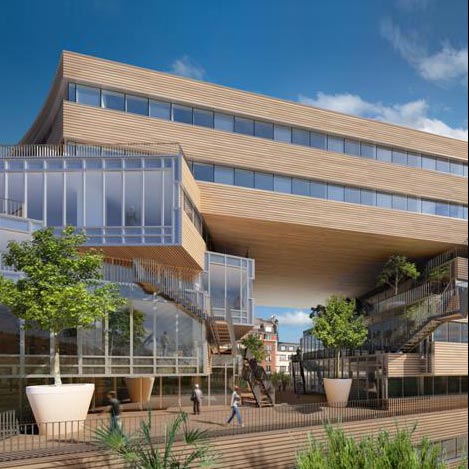 |
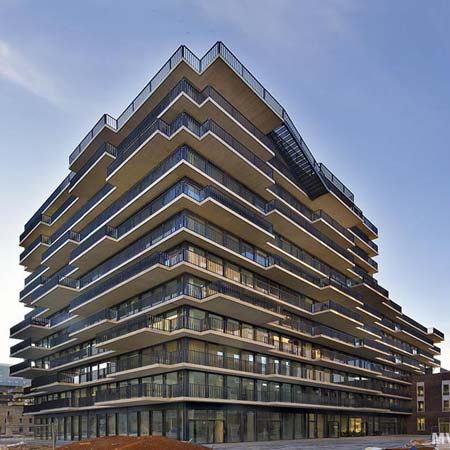 |
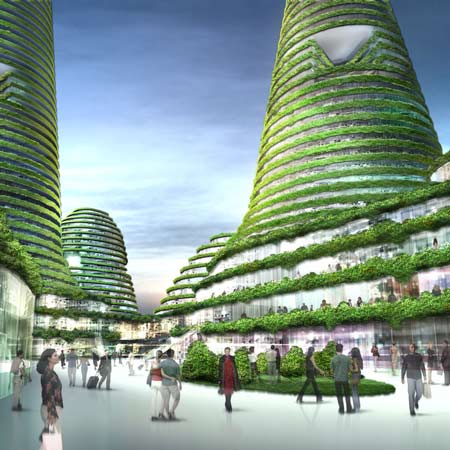 |
| Pushed Slab Building by MVRDV |
Westerdok Apartment Building by MVRDV |
Gwanggyo Power Centre by MVRDV |